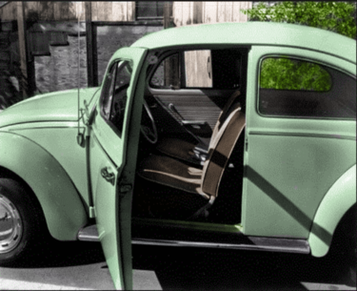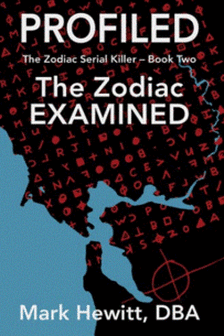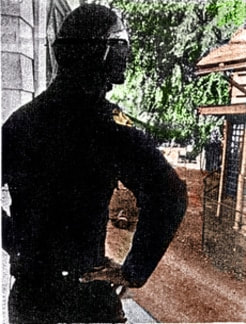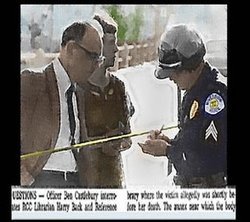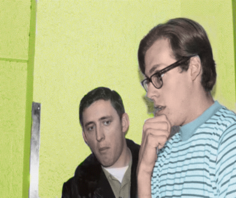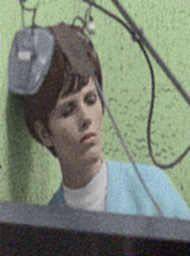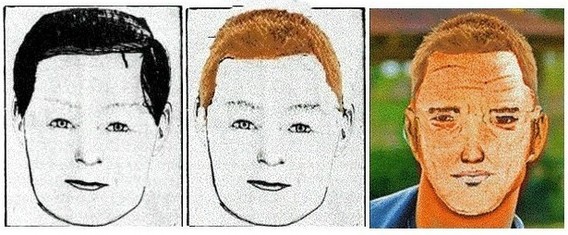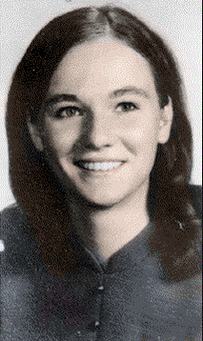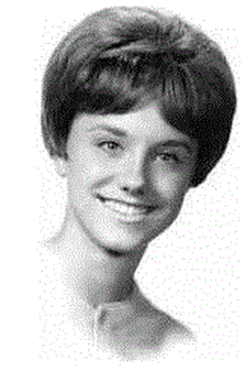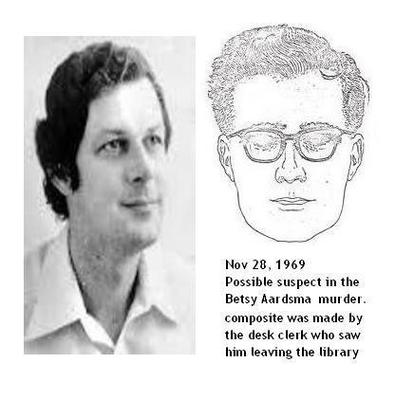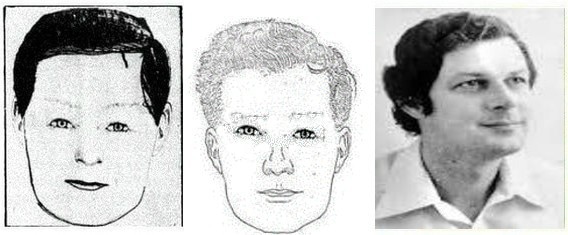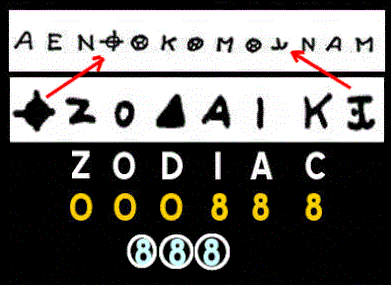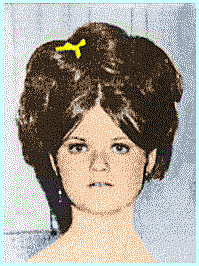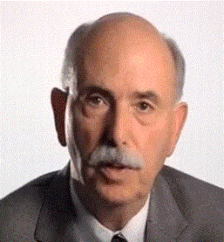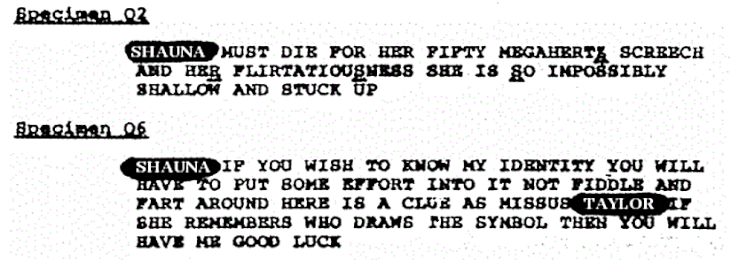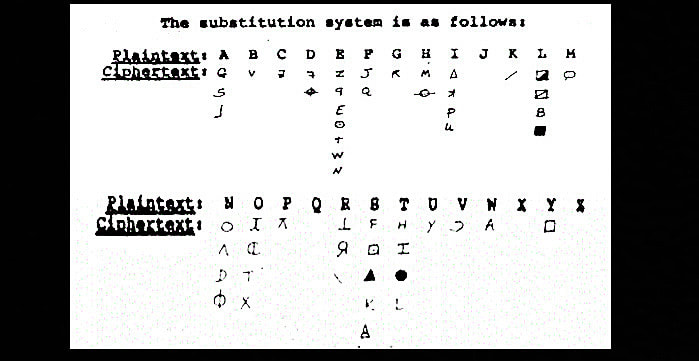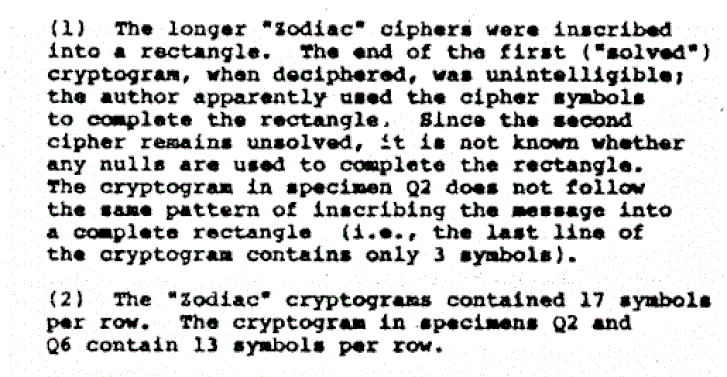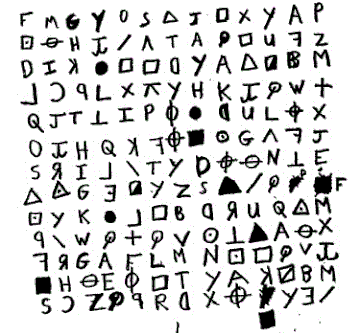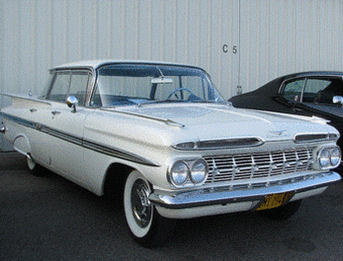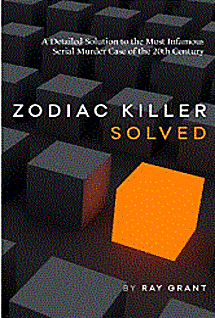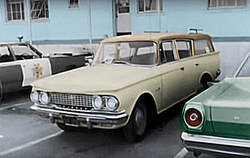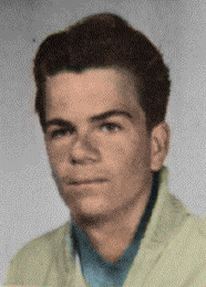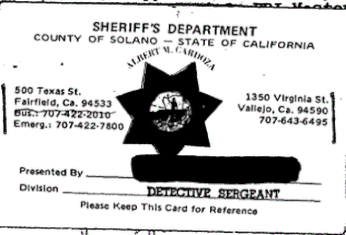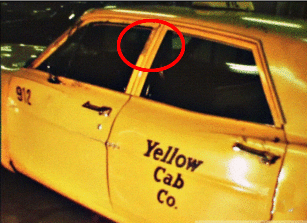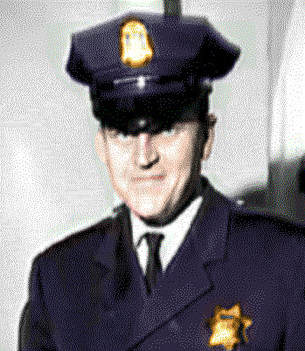The following has been covered many times before on this site, but on this occasion we will examine the premise of two assailants present in the rear of Paul Stine's taxicab at the intersection of Washington and Cherry Streets on October 11th 1969. It is not necessarily a position I subscribe to, however in the interest of neutrality it must be examined. This will not be based on speculation, it will be reasoned using the three teenage eyewitnesses and the timelines of Donald Fouke and Armond Pelissetti, two of the initial police responders that night.
Many eyewitnesses involved in the Zodiac crimes have changed, if not embellished their testimony down the years, and rightly must treated with skepticism. An ever changing and elaborate story is to be considered suspect. But what we notice in the police report of the Paul Stine murder is very little detail. A report only one and a half pages long, drafted by the following morning of October 12th 1969. The three teenagers have been noticeably quiet during the last 48 years, in which publicity seeking opportunism could certainly not be leveled at them. They gave a second account of the night's events on October 11th 1969, and although one usually sneers at second, third and fourth generation accounts of the same event, their full account of the murder of Paul Stine was never originally heard and documented in a rather limited police report. Their recounting of events at a later date carries much weight, because not only does it explain why a blooded fingerprint was found on the dividing panel, between Paul Stine's driver side door and the left rear passenger door, but their testimony is fully corroborated by the statement of Armond Pelissetti on the 2007 Zodiac documentary.
![Picture]() Click to enlarge
Click to enlarge This is the statement of the Robbins teenagers "As both Robbins kids were the oldest, their statements were the given the most weight. Also they were the least traumatized by the event. One of the kids (not sure which) noticed a cab parked outside (in that now famous spot) with the interior lights on. So when Lindsey told me that the light inside the car was like a spotlight, it was so bright.
The first kid at the window said the driver looked "sick, or something". Lindsey and Rebecca went to the window and saw the driver laying across the front seat, head toward the passenger door. His head was in the lap of another man (passenger). Rebecca saw blood and said out loud, "he's stabbing that man." She was seeing blood on the victim and saw the glint of a knife, so she assumed a stabbing was taking place. (No shots were heard by anyone). We know now that Zodiac was cutting off a large piece of Stine's shirt with the knife.
At this time, Lindsey went downstairs to get a better look at what was happening, while one of the kids upstairs called the police. Downstairs, the lights were off, so Lindsey knew he could not be seen from the outside. He got close to the window and watched his actions. He was shortly joined by Rebecca. They both watched and observed in silence as Zodiac pushed the driver to an upright position behind the steering wheel, exited the car and walked around the rear of the car and opened the driver's door. Stine had fallen over onto the seat and Zodiac pulled him back up into the seated position and had some difficulty keeping him upright. Once upright, he was seen to have a rag, or something like a handkerchief and began to wipe down the door area and leaning over the driver, part of the dashboard. When he was finished, Zodiac calmly walked to Cherry St. and walked north.
Not many know this, but Lindsey (being 16. feeling immortal, and believing the suspect to be armed with only a knife) ran out of his door to see where Zodiac was going. He ran to the corner of Cherry and watched as Zodiac continued his casual pace right up to the corner of Jackson & Cherry.
At this exact point, the first SFPD car arrives with two officers. One, Pelissetti, approached Lindsey and tried to extract what was happening. The other officer went to the cab and found the bloody victim. While Pelissetti was asking questions, Lindsey was trying to explain that the suspect was in sight on Cherry St. By the time Pelissetti got the point, they both looked and the Zodiac was gone."
![Picture]()
There are two key points to remember in this account:
#1. "They both watched and observed in silence as Zodiac pushed the driver to an upright position behind the steering wheel, exited the car and walked around the rear of the car and opened the driver's door. Stine had fallen over onto the seat and Zodiac pulled him back up into the seated position and had some difficulty keeping him upright."
The 'Zodiac' could likely have deposited blooded fingerprints on the taxicab door divider as he braced his right hand to lever Paul Stine back to a seated position, albeit he didn't remain in this position.
#2. "Not many know this, but Lindsey (being 16. feeling immortal, and believing the suspect to be armed with only a knife) ran out of his door to see where Zodiac was going. He ran to the corner of Cherry and watched as Zodiac continued his casual pace right up to the corner of Jackson & Cherry."
This was backed up by Armond Pelissetti in the 2007 documentary "We responded to a radio call that told us a cab driver was being robbed and possibly assaulted at the corner of Cherry and Washington Street in Pacific Heights. We fortunately were very close and responded to that corner, and able to do so red light and siren, and got there very quickly. I parked the car in the middle of the intersection, facing the Yellow Cab. There were three children that were heading over to that car, they were about 15 or 16 feet away. I made the assumption they were coming from the home on the corner and herded them immediately back to that alcove. I didn't know if the suspect was still there..... It was then I was told it was a white male, I couldn't get to the radio fast enough at that point to let everybody else know. The kids had told me whoever had done this crime had left the cab, went out the door and seemed to be wiping the cab down and reaching into the cab and ambling or walking down Cherry Street in a northerly direction, kind of towards the Presidio. I walked that way myself, I did not run because there are innumerable alcoves and parked cars, so I went down following every technique I knew so I didn't get my head blown off."
It is clear from Armond Pelissetti's statement and that of the three teenagers, that indeed they were milling around near the intersection of Washington and Cherry, not confined in their residence throughout, as one could easily interpret from the police report alone. The testimony of the three teenagers however provides a massive headache regarding the perceived order of events that night.
![Picture]() Donald Fouke
Donald Fouke The attack was logged at 9.55 pm, with the police dispatcher sending out the radio message to responding officers at 9.58 pm. This meant that Donald Fouke and Armond Pelissetti both received the initial broadcast at 9.58 pm.
Donald Fouke stated he was traveling northbound on Presidio Avenue, having just passed Washington Street. Armond Pelissetti we shall come to shortly.
Donald Fouke stated he saw a male subject as he was approaching the Jackson and Maple intersection. The white male adult was close to the intersection. The traveling distance to this point for Donald Fouke is exactly 862 meters (0.5 mile). He stated after receiving the initial broadcast he was traveling at 35-40 mph, but taking into account slowing for crossing the intersections, it has been calculated that his journey time to the Jackson and Maple intersection from his original position, would have been approximately 1 minute. This places him at the Jackson and Maple intersection at 9.59 pm.
This also places the mystery man here at 9.59 pm.
The author of the 'Bus Bomb' letter one month later stated that "p.s. 2 cops pulled a goof abot 3 min after I left the cab. I was walking down the hill to the park when this cop car pulled up + one of them called me over + asked if I saw anyone acting suspicious or strange in the last 5 to 10 min + I said yes there was this man who was runnig by waveing a gun & the cops peeled rubber + went around the corner as I directed them + I disappeared into the park a block + a half away never to be seen again".
The movements of Donald Fouke and Eric Zelms were never publicized in the newspapers before November 9th 1969, indicating that the author of the 'Bus Bomb' letter knew the exact location of where Donald Fouke's patrol car was at exactly the right time. This means the man spotted by Donald Fouke was the author of the 'Bus Bomb' letter. But was he the killer.
The journey time up Cherry Street is 1 minute. The journey time from the top of Cherry to the intersection of Jackson and Maple is 2 minutes, corroborating the letter writer when he stated "p.s. 2 cops pulled a goof abot 3 min after I left the cab". Working backwards, this places the mystery man at the top of Cherry at 9.57 pm, and leaving the taxicab at 9.56 pm. (shown on the map below).
Now remember what the three teenagers stated "Not many know this, but Lindsey (being 16. feeling immortal, and believing the suspect to be armed with only a knife) ran out of his door to see where Zodiac was going. He ran to the corner of Cherry and watched as Zodiac continued his casual pace right up to the corner of Jackson & Cherry.
At this exact point, the first SFPD car arrives with two officers. One, Pelissetti, approached Lindsey and tried to extract what was happening. The other officer went to the cab and found the bloody victim. While Pelissetti was asking questions, Lindsey was trying to explain that the suspect was in sight on Cherry St. By the time Pelissetti got the point, they both looked and the Zodiac was gone."
When Armond Pelissetti arrived the suspect was in sight approaching the corner of Jackson and Cherry. We know from the diagram above, this was 9.57 pm. Therefore Armond Pelissetti must have arrived at 9.57 pm. This however is very odd, as Armond Pelissetti didn't even get the initial broadcast until 9.58 pm, and still had to travel to the scene "red light and siren."
We know that Armond Pelissetti didn't arrive at the crime scene at 9.56 pm or earlier, because we know Zodiac left the taxicab at 9.56 pm and reached the top of Cherry at 9.57 pm. He couldn't have arrived at 9.56:30 pm, because the mystery man would have only journeyed half way up Cherry (30 seconds traveling time on a 1 minute street). So it is clear that Armond Pelissetti did arrive at 9.57 pm. Therefore Armond Pelissetti received the initial broadcast prior to 9.57 pm. He stated in the Zodiac 2007 documentary "We fortunately were very close and responded to that corner, and able to do so red light and siren at 9.55 pm at night, and got there very quickly."
This time of 9.55 pm makes perfect sense. They "were very close" and would have been exactly two minutes traveling time from the intersection of Washington and Cherry when they received the initial broadcast, arriving at the intersection at 9.57 pm, just as Zodiac was approaching the top of Cherry. This means the logged attack and initial broadcast would have been 9.55 pm, not 9.58 pm, as detailed in the police report. But here is the major problem.
![Picture]()
Donald Fouke received the initial broadcast at the same time as Armond Pelissetti. So if Armond Pelissetti received the initial broadcast at 9.55 pm, Donald Fouke received it at 9.55 pm. His journey time traveling northbound on Presidio Avenue, having just passed Washington Street (his initial position that night) to the intersection of Jackson and Maple is again 1 minute. He would now arrive at Jackson and Maple at 9.56 pm, where he viewed the suspect. The problem is, we know from all the above facts, along with the map, that 'Zodiac' had left the taxicab crime scene at 9.56 pm. He cannot be in both places at the same time, separated by 3 minutes walking time. This is a major discrepancy, if we use the corroborated timeline of Armond Pelissetti and the three teenagers.
This would place 'Zodiac' leaving the crime scene at 9.56 pm, and approaching the Jackson and Maple intersection at 9.56 pm.
We surely cannot have Donald Fouke spotting 'Zodiac' at 9.56 pm, because this would have him leaving the taxicab at 9.53 pm, two minutes before the actual attack occurred. Additionally, Armond Pelissetti would not have been at the Washington and Cherry intersection, when Zodiac was apparently approaching the northern edge of Cherry at 9.57 pm (it doesn't take 'Zodiac' 4 minutes to walk up Cherry). So could Donald Fouke have been mistaken and never saw the Zodiac Killer at all. This doesn't seem likely, as we know the author of the 'Bus Bomb' letter knew that "2 cops" were present at the intersection of Jackson and Maple that night, something not disclosed in the newspapers. So is it possible Donald Fouke saw the "letter writer" traveling along Jackson Street, but not his accomplice, who was just leaving the taxicab. We know that Donald Fouke in the 1989 'Crimes of the Century' documentary, stated that after receiving the initial broadcast "We proceeded on Jackson Street towards Arguello continuing our search, as we arrived at Arguello Street the description of the suspect was changed to a white male adult, believing this suspect was possibly the one involved in the shooting we entered the Presidio of San Francisco and conducted a search on West Pacific Avenue, the opposite side of the wall and the last direction we observed the suspect going, we did not find the suspect." The question arose, as to why Donald Fouke was heading towards Arguello Boulevard, away from the crime scene of an "assault and robbery," when he should have been heading towards it. The logical assumption was that he did indeed stop 'Zodiac,' and Zodiac directed him that way. If there were two assailants, and one was still present near or at the crime scene, it would make perfect sense for the accomplice on Jackson Street to direct Donald Fouke away towards Arguello Boulevard to protect his accomplice.
![Picture]()
The teenagers never saw the taxicab pull up to the corner of Washington and Cherry Streets. They only began observing the crime when the man was already in the front of the taxicab. They never observed or heard the shooting, so it could never be claimed as fact or certainty, that the man observed tearing a swatch of Paul Stine's shirt was the actual killer of the taxicab driver. His accomplice may have already shot Paul Stine and cleared the intersection of Washington and Cherry Streets before the three teenagers even looked out of the window.
If this man (the actual killer) was the man spotted by Donald Fouke at 9.56 pm by Jackson and Maple, he would have left the taxicab at 9.53 pm, before the teenagers looked out of the window at approximately 9.55 pm, and would now back up the timeline of Donald Fouke receiving the initial broadcast at 9.55 pm. This man may very well have been the trigger man, while his accomplice stayed behind to secure the swatch of Paul Stine's shirt. This would have been the man observed by the three teenagers, not the killer. This would have reduced the risk of capture for the man holding the 'smoking gun.' Had the police arrived as his accomplice was tearing a piece of shirt, he could simply have claimed to be a passer by, who was aiding the stricken taxicab driver. After all, Paul Stine was shot, and this man possessed no gun.
This places the killer at Jackson and Maple at 9.56 pm, and his accomplice leaving the scene of crime at 9.56 pm. Donald Fouke is directed to Arguello Boulevard by the killer, leaving a clear path for his accomplice traveling up Cherry to a predetermined destination and meeting place.
![Picture]()
This lends credence to arguments given by such people as Thomas Horan, who claim that the individual seen by the three teenagers and Donald Fouke are actually two separate people. Here are the two descriptions given:
#1. The three teenagers stated the killer was "A white male, 25-30 years old, 5'8" to 5'9", stocky build, reddish-brown hair worn in a crew cut, heavy rimmed glasses and dark clothing."
#2. Donald Fouke in his typed memorandum of 12th November 1969 stated he was a "WMA, 35-45 yrs, about 5'10", 180-200 lbs, medium heavy build, barrel chested, medium complexion, light colored hair possibly graying in rear, crew cut, wearing glasses."
There is a discrepancy in hair color and a marked deviation in age. Donald Fouke would later remark on the sketch of the suspect given by the three teenagers, stating he believed the suspect to be "older and heavier." However he never apparently challenged the facial description of the suspect. So was he mistaken and just went along with the facial description, or was it the same person all along. The timeline seems to challenge this notion. Were the two accomplices related, wearing the same disguise or just visually similar, with a crew cut and glasses?
As stated at the beginning, I am not closed to the idea of two assailants at Presidio Heights on October 11th 1969, but neither am I totally convinced either. The timeline is the key.

